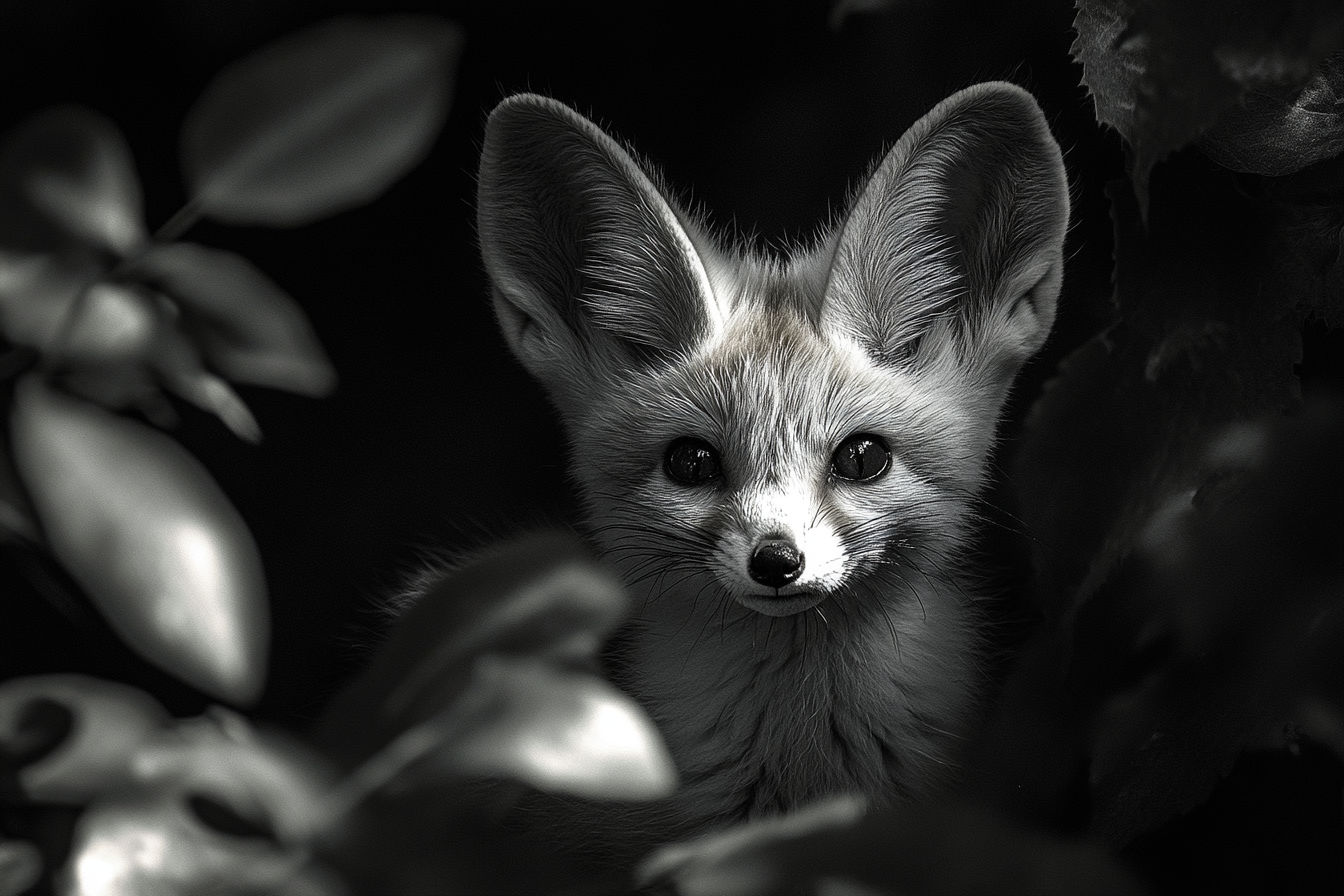The Ultimate Guide to a Fennec Fox’s Dinner: What’s on the Menu in the Sahara?
Curious about how fennec foxes survive in the harsh Sahara Desert? From insects to fruits, explore the surprising variety in their diet and how they meet their nutritional needs.

This post may contain affiliate links. If you make a purchase through these links, we may earn a commission at no additional cost to you.
Ever seen a picture of a fennec fox? They’re the smallest foxes in the world, famous for their absolutely massive ears and tiny, fluffy bodies. They look like something straight out of a Disney film. But don’t let their cute looks fool you. These little creatures are tough survivors, perfectly built for one of the harshest places on Earth: the Sahara Desert.
Living in a massive sea of sand means finding food is a real challenge. There aren’t any supermarkets or takeaways out there. So, what exactly do these little foxes eat to survive? It’s a question that reveals just how clever and adaptable they are. Their diet isn’t just about what they can find; it’s about how their bodies are designed to get every last drop of goodness from their meals.
In this guide, we’re going on a deep dive into the fennec fox’s diet. We’ll uncover the secrets of their hunting skills, explore their favourite snacks, and see how they manage to find water when there’s none to be seen for miles. It’s a story of survival, clever tricks, and a menu that’s more varied than you might think. So, let’s get started and find out what’s for dinner in the world of the fennec fox.
A Fox Built for the Desert: Understanding the Fennec
Before we look at their food, it helps to understand the animal itself. A fennec fox (Vulpes zerda) is a true masterpiece of desert evolution. Every part of its body has a special job to help it thrive where other animals would struggle.
First up, those enormous ears. They aren’t just for show. They work like brilliant satellite dishes, picking up the tiniest sounds from under the sand. A beetle scuttling deep underground or a mouse twitching its whiskers? A fennec fox can hear it all. These ears also have another cool trick. They’re filled with blood vessels that help the fox lose heat, acting like a built-in air conditioning system to keep it cool under the blazing desert sun.
Then there’s their size. Fennec foxes are tiny, usually weighing only about 1.5 kilograms—that’s not much more than a bag of sugar. Being small means they don’t need a massive amount of food to keep going, which is a big advantage in a place where meals can be few and far between.
Their coat is another clever feature. It’s a thick, sandy-coloured fur that does two jobs. During the day, it reflects the sunlight, stopping the fox from getting too hot. At night, when desert temperatures can drop below freezing, it acts as a cosy blanket, keeping them warm. Even the bottoms of their paws are covered in fur. This protects their feet from the scorching hot sand, a bit like wearing a pair of furry slippers.
Fennec foxes are also nocturnal. This means they sleep during the hottest part of the day in cool burrows they dig under the sand and come out to hunt at night when it’s much cooler. They are social animals, living in family groups of up to ten individuals. These burrows can be huge, sometimes with multiple entrances and exits, making a safe and comfortable home for the whole family.
All these features—the ears, the size, the coat, and their night-time lifestyle—come together to create an animal perfectly suited to desert life. And it’s these same features that make them such brilliant hunters.
The Main Course: What Fennec Foxes Really Eat
So, what’s on the menu? Fennec foxes are omnivores, which means they eat a bit of everything—both meat and plants. This flexible diet is the secret to their success. When you live in the desert, you can’t afford to be a picky eater. You have to take whatever you can get.
Their diet changes with the seasons and depends on what’s available. But generally, it’s a mix of insects, small animals, and the occasional plant-based treat.
King of the Creepy-Crawlies: Insects Galore
The biggest and most reliable part of a fennec fox’s diet is insects. They are bug-hunting experts. Their huge ears can hear the faint sounds of beetle larvae wriggling under the sand or the flutter of a moth’s wings in the dark.
Some of their favourite insect snacks include:
- Locusts and Grasshoppers: These are a fantastic source of protein. When swarms of locusts appear in the desert, it’s like an all-you-can-eat buffet for fennec foxes. They will leap and pounce to catch them.
- Beetles: From dung beetles to scarab beetles, these crunchy critters are a staple food. The foxes use their sharp hearing to locate them and then their paws to dig them up quickly.
- Scorpions and Spiders: You might think a scorpion is a dangerous meal, but fennec foxes are quick and clever. They can kill a scorpion with a swift bite, avoiding the sting.
- Termites: Another great source of food, especially when they can find a nest.
Insects are a brilliant food source in the desert because they are plentiful and don’t require a huge amount of energy to catch. For a small fox, a belly full of beetles is a dinner well earned.
The Thrill of the Hunt: Small Animals on the Menu
While insects are the bread and butter of their diet, fennec foxes are also skilled hunters of small animals. This is where their stealth, speed, and incredible hearing really shine. They hunt alone, using the darkness of the desert night to their advantage.
Their hunting technique is a classic fox move: a silent stalk followed by a high-arched pounce. They can leap surprisingly high into the air to bring their paws down on their prey, pinning it to the ground before delivering a final bite.
The small animals they hunt include:
- Rodents: Little desert dwellers like gerbils, jerboas, and mice are a top prize. These animals are fast, but a fennec fox is faster.
- Lizards and Geckos: The desert is home to many reptiles, and these make a tasty meal. The foxes will snatch them from rocks or dig them out from their hiding places.
- Birds and Eggs: Fennec foxes are good climbers and will raid the nests of small birds that nest on the ground or in low shrubs. They’ll eat both the eggs and any chicks they can find. Bird eggs are packed with fat and protein, making them a super nutritious snack.
- Snakes: They will even take on small desert snakes, using their lightning-fast reflexes to avoid being bitten.
Hunting these animals requires more energy than digging for beetles, but the reward is a much bigger, more protein-rich meal.
A Bit on the Side: The Plant Part of Their Diet
It’s not all about the chase. Fennec foxes also eat plants to supplement their diet. This is especially important for getting certain vitamins and, crucially, water.
The plant-based part of their diet includes:
- Roots and Tubers: Using their strong paws, they dig for underground roots. These are a great source of moisture and carbohydrates. It’s like finding a potato in the middle of the desert.
- Berries and Fruits: When they can find them, fennec foxes will happily munch on desert berries and fruits from the few plants that can survive in the Sahara, like the desert gourd. These provide sugar for a quick energy boost.
- Leaves: They will sometimes chew on leaves, likely to get extra moisture.
While plants don’t make up a huge part of their calorie intake, they are a vital part of staying healthy and hydrated in a dry environment. Being an omnivore gives the fennec fox a massive advantage—it can switch between food sources depending on what is available. If there’s a drought and not many plants are growing, they can focus on hunting. If prey is scarce, they can dig for roots. It’s this flexibility that makes them such brilliant survivors.
How to Eat in the Desert: Clever Hunting Tricks
Having a varied diet is one thing, but you still have to catch your food. Fennec foxes have developed some amazing techniques for finding and catching a meal in the vast, empty desert.
The Super-Powered Hearing
As we’ve mentioned, those ears are their primary hunting tool. At night, a fennec fox will often stand completely still, turning its head from side to side. It’s not admiring the view; it’s listening. It can pinpoint the exact location of prey moving under several inches of sand. This is an incredible skill that scientists are still studying. It’s like having built-in X-ray hearing.
Once it locks onto a sound, the fox quietly creeps closer. Its furry paws mean its footsteps are almost silent on the sand.
The Digging Machines
When the prey is underground, the fennec fox turns into a digging machine. It uses its front paws to dig at an incredible speed, sending sand flying. It can excavate a small lizard or a beetle larva in seconds. This speed is essential because their prey won’t wait around to be caught.
The Pounce Attack
For prey that’s out in the open, like a jerboa or a grasshopper, the fennec fox uses its signature pounce. It crouches down low, wiggles its back end, and then launches itself into the air. This high pounce helps to surprise the prey and ensures the fox lands on it with enough force to stun or kill it instantly. It’s a very effective, energy-efficient way to hunt.
Storing Food for Later
Fennec foxes are also known to cache their food. This means if they kill something too big to eat in one go, like a larger rodent, they will bury it in the sand to save for later. They’ll dig a hole, drop the food in, and cover it back up. This is a common behaviour among foxes worldwide and is a smart way to make sure no food goes to waste. In the desert, you never know when your next meal will be, so having a hidden stash is a great insurance policy.
The Biggest Challenge: Finding Water in the Desert
Food is one thing, but what about water? The Sahara Desert is one of the driest places on the planet. There are no rivers or lakes for a fennec fox to have a drink. So how do they survive without dying of thirst?
This is perhaps the most incredible part of their biology. Fennec foxes are so well-adapted to desert life that they can get almost all the water they need from their food.
Water from Food
When they eat insects, rodents, or lizards, they are not just getting protein and fat; they are also getting the water that is stored in their prey’s bodies. Fresh meat is full of moisture. The same goes for the roots and berries they eat. These plants have to store water to survive, and the fennec foxes take advantage of that.
Super-Efficient Kidneys
To hold onto every last drop of water, fennec foxes have developed incredibly efficient kidneys. Their bodies are brilliant at recycling water and producing very concentrated urine. This means they lose very little water when they go to the toilet. It’s a bit like having a high-tech water-saving system inside their bodies.
Behavioural Tricks
They also use behaviour to save water. By being active only at night, they avoid the scorching heat of the day, which means they don’t lose much water through panting. When they do pant to cool down, they do it very rapidly but shallowly, which helps to minimise water loss.
They will also sometimes lick the dew that forms on plants or rocks in the cool early mornings, but their primary source of hydration comes directly from the food they eat. They have evolved to a point where they don’t need to drink standing water at all, though they will if they happen to come across it after a rare desert rain shower.
What Happens When Food Is Scarce?
Life in the desert is unpredictable. Some years there might be plenty of rain, leading to a boom in plant life and, in turn, more insects and rodents. But other years can be incredibly dry and barren.
Fennec foxes have ways of dealing with these lean times.
- Lower Metabolism: They have a naturally slow metabolism for their size, meaning they burn energy more slowly than other animals. This helps them get by on less food.
- Switching Food Sources: As we’ve seen, their omnivorous diet is key. If rodents are hard to find, they will spend more time digging for insects and roots. They eat what’s available.
- Family Support: Living in social groups can also be a big help. While they hunt alone, the family shares a burrow. This cooperation can make life easier, especially when raising young.
The young foxes, called kits, are born in the spring. The mother stays with them in the burrow while the father and other family members go out to hunt and bring food back for her. This teamwork gives the kits the best possible start in life.
Threats to the Fennec Fox’s Dinner Table
Fennec foxes are not currently considered an endangered species. They are widespread across North Africa and the Sahara. However, they do face some threats, many of which are related to their food supply and habitat.
- Habitat Loss: Human expansion into the desert for things like road building and new settlements is a major threat. When their habitat is disturbed, it can disrupt the entire food chain. Fewer plants mean fewer insects, which means fewer lizards and rodents, and ultimately, less food for the foxes.
- Climate Change: A changing climate could make the already harsh desert environment even more extreme. Longer droughts could make it even harder for plants and animals to survive, putting pressure on the fennec fox’s food sources.
- The Pet Trade: Sadly, their cute appearance has made fennec foxes popular in the exotic pet trade. People trapping them for sale can reduce their numbers in the wild. While this isn’t directly a threat to their diet, it puts pressure on their populations. A fennec fox is a wild animal and is not suited to life as a pet. They are nocturnal, energetic, and need a very specific environment to thrive.
Protecting the desert ecosystem is the best way to protect the fennec fox and ensure it has a healthy and varied diet for years to come.
A Perfectly Balanced Desert Diet
The diet of a fennec fox is a fascinating story of adaptation and survival. From the tiniest beetle larva to a speedy desert mouse, they have a menu that is perfectly tuned to their environment. Their omnivorous nature allows them to be flexible, and their incredible physical features make them expert hunters.
They are a powerful reminder that even in the most challenging places on Earth, life finds a way not just to survive, but to thrive. Those giant ears, that sandy coat, and that clever, varied diet all come together to make the fennec fox a true master of the desert.
So, the next time you see a picture of this tiny fox with its outsized ears, you’ll know there’s more to it than just good looks. You’ll know you’re looking at one of nature’s most skilled and resilient survivors, an animal that has perfected the art of finding dinner in a sea of sand.
Further Reading
For those interested in learning more about fennec foxes and desert ecosystems, here are some excellent resources:
- National Geographic: https://www.nationalgeographic.com/animals/mammals/facts/fennec-fox
- WWF (World Wildlife Fund): https://www.worldwildlife.org/species/fennec-fox
- IUCN Red List of Threatened Species: https://www.iucnredlist.org/species/41588/46173447






